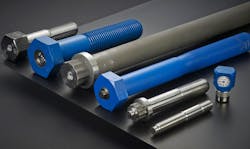Load-Indicating Fasteners Maximize Control
Many forging operations produce high-value, critical parts, but custom-designed, engineered parts are more notable novelties. For more than 40 years, Valley Forge & Bolt Manufacturing Co. in Phoenix has been producing hot-forged industrial fasteners. In addition to forging the plant has heat-treating, threading, and machining capabilities, but it is best known for its patented MaxBolt load-indicating fasteners. Each MaxBolt™ fastener features a tiny, built-in gauge that continuously measures and indicates the level of tension being exerted on the bolt: the gauge continuously measures and displays the amount of tension in a bolt or stud.
Maxbolt fasteners are manufactured by inserting highly accurate and durable, load-monitoring devices into high-quality bolts and studs. Accurate assembly and continuous monitoring during production reduce the potential for premature wear, expensive downtime, and catastrophic joint failure.
According to Valley Forge & Bolt, load-indicating fasteners are compatible with conventional tightening and tensioning equipment and eliminate the need for ultrasonic, strain gages, and torque measuring devices. The system offers a simple and reliable method for accurate joint assembly, and helps to maintain the integrity of the bolted joint.
While Maxbolt products represent a valuable brand for the forger, the value to manufacturing, fabricating, or assembly projects is equally important. Some critical joints require "controlled bolting" throughout their performance life to maintain performance, or to enhance safety, save time, and improve uptime. However, the term is more often applied to installation than to the service life of the bolted joint. Valley Forge & Bolt’s load-indicating fasteners make it possible to monitor bolted joints after installation and to always know fastener tension, regardless of the service interval.
So far no one has developed a bolt that tightens itself, but the tension-based monitoring system of Valley Forge load-indicating fasteners offer much greater accuracy than torque-based methods.
Valley Forge controlled bolting technology makes it possible to measure the tension directly from the bolt, not relying on inexact, torque-based measurements. Accurate to +/-5% of minimum yield of the fastener, and ASTM F2482-compliant, these bolted joints can report the exact percentage of load they are bearing, at any time.
This load-indicating fastener technology is available with the Maxbolt™ Load Indicating Fasteners and the SPC4™ Load Indicating System. Each fastener tells indicates its percentage of minimum yield on a 0-to-100 scale, using either a built-in meter (Maxbolt) or, in the case of bolts with SPC4 technology, using quick-connect meters or wireless sensors to provide a precise measure of the load.
Catastrophic joint failure is costly and dangerous, underscoring the need for accurate, consistent, and repeatable controlled bolting. Yet measuring torque to determine tension is inaccurate, indirect, and inadequate.
With Maxbolt and SPC4, any technician with any level of experience can achieve accurate, consistent, and repeatable bolting, not only at installation but throughout service life. At maintenance intervals, he will know the accurate tension quickly and will have to tighten only those fasteners that require it. Wireless-compatible SPC4 can be integrated into a plant’s condition-monitoring system for remote readings and in-use monitoring.
The result is a joint-fastening solution that promises accurate tensioning for the service life of a fastener, increases speed of installation and maintenance, and saves labor costs, increasing safety and improving performance.
